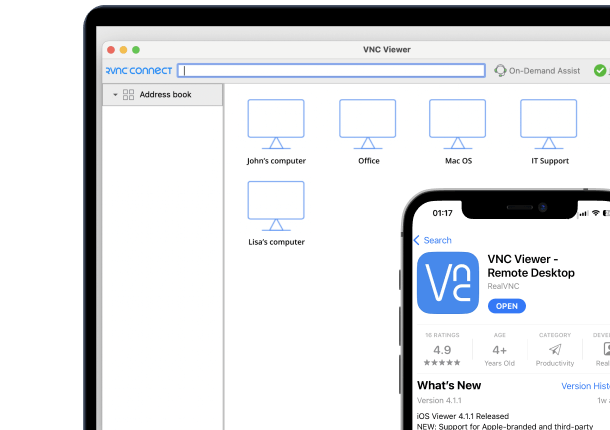As a way of centrally managing a distributed estate of devices, remote access technology supports a more fluid and flexible working environment.
A secure remote access strategy contributes to a competitive 24/7, real-time working culture, and thanks to technical advancements in the workplace, businesses have the freedom to acquire the best talent worldwide, remove silos and promote collaboration between locations, offices and teams.
Historically, remote access was deployed as a tool only for IT and administration support.
Today, we’re challenging this perception with the many opportunities this technology brings to an organization. The foundation of this shift was built on the enhanced access to company resources provided by a remote connection solution.
Here, we discuss the most common flexible working benefits that can be supported by your remote access strategy.
1. A more productive workforce
It’s surprising what eliminating or reducing a commute can do for productivity: the traffic pile-up, the stuffy public transport, the delayed train – all impact on the stress and happiness levels of a workforce.
Without the regular commute, employees can enjoy a more stress-free start to their day, leading to a more engaged, focused and motivated workforce.
What does this mean for productivity? Well, as much as 2 hours a day could be regained and ploughed back in the business. Workers are said to work in excess of 40 hours a week when given the opportunity to work from home. It also reduce tardiness and absenteeism.
Through a remote access solution, users can securely access office IT resources or their desktops at home on any device.
So, if employees are traveling or need to tend to personal errands, they are free to dip in and out of work-related tasks, maintaining their productivity and work/life balance.
2. Better talent acquisition
With a remote access strategy and flexible working initiatives, businesses can acquire high quality talent worldwide.
Location is no longer a restricting factor to the best talent acquisition. And leaders can employ the best-suited person for the job, regardless of location, giving remote teams access to all centrally-held IT resources, as well as any support they may need.
Widening the reach beyond their immediate surroundings allows businesses to select from a larger pool of potential candidates for recruitment.
3. IT support from anywhere
If users are struggling with IT issues, even when working away from the office, support staff are able to log in remotely and help them.
This can make working from home as efficient and interruption-free as possible. It also limits the need for on-site support, allowing IT teams to be more productive.
Service providers and IT can access remote systems and devices to ensure they are continuously updated, maintained and resistant to downtime risks – another contributor to productivity and business continuity.
4. Improved security for remote workers
Security will always be a concern for businesses considering flexible working initiatives. But no matter the devices used or their location, you can be protected from cyber threats with a secure remote access solution from a trusted vendor.
Users logging in from different locations and devices are protected, as are files and data since they don’t need to be distributed across corporate and personal devices.
With remote access, security assurance is available even when working from home or the local coffee shop. Files, resources and data can be protected with end-to-end encryption and multi-factor authentication. To learn more about the essential security features to look for in your screen-sharing solution, download our free remote access security checklist.
5. Lower overhead cost
When employees are working away from the office regularly, they are not using valuable desk space, equipment, stationery, and other amenities required by office-bound employees that can rack up business-running costs.
Also, by underpinning a secure, accessible BYOD (Bring Your Own Device) policy, a remote access strategy can reduce the costs of supporting runaway device proliferation. Employees can use their own devices to access centrally-controlled IT resources.
By doing so, organizations can avoid paying for and supporting multiple software licenses for different devices.
BYOD can help future-proof an organisation, making them attractive employers for the coming generations of digital natives whose devices are as personal as their toothbrushes.
And, when it’s done right, it can deliver happier workers, reduced IT overheads and increased productivity.
6. Business continuity planning
Business disruptions can take many forms, from natural disasters to human-made problems like transit strikes or power failures. There are countless scenarios that could mean employees are prevented from getting to the office – or even that the office is out of service.
The COVID-19 pandemic is a significant example of just how quickly things can change on a global scale. Businesses worldwide were put to the test, suddenly faced with government mandates preventing them from conducting business as usual in the interest of public health.
While most disaster recovery strategies detail recovery for servers and data, organisations should also consider how workers will be able to securely and efficiently access company data from alternative locations.
A good remote access solution can alleviate many concerns associated with lack of physical access to equipment essential for business operations.
When thinking about remote access as part of business continuity planning, companies should try and answer several questions:
- How will workers be able to get access quickly?
- Will users maintain their usual performance standards?
- Will first-time users require assistance from overworked IT staff?
- Can the remote access solution handle the increased load?
- Are additional licenses for new users easily obtainable?
Flexible working has proven to be advantageous to both businesses and employees, and it’s becoming increasingly popular. For example, data collected by the UK’s Office for National Statistics suggest that half of the country’s workforce is expected to work remotely by 2020.
The business benefits of working from home take many forms, such as an increase in productivity and employee retention. A remote access strategy can be tailored to suit the flexible working needs of any size or type of business.
Try it out for yourself with a free 14-day trial of VNC Connect, the #1 simple, secure remote access solution.






